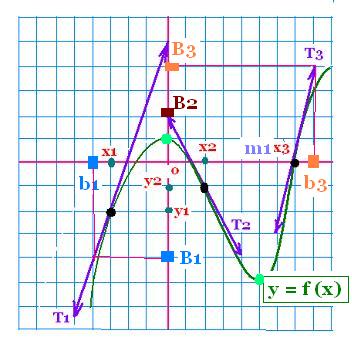Calculus I
Limits
Derivative
Exercices
Applications
Marginal analysis
© The scientific sentence. 2010
|
Calculus I: Geometric Interpretation of the derivative
1. Slope and derivative
Let's draw some lines passing through two points on the curve
of equation y = f(x):
one fixed of abscissa xo and another of abscissa x moving
toward the fixed point.
As x approaches xo, the secant line becomes
the tangent line at the end. Its slope "a" becomes equal to the derivative f'(xo)
of the function y = f(x) at the point xo.
Geometrically, the slope "a" is equal to the average rate of change:
a = (yf - yi)(fx - xi)
yf and yi are any two ordinates corresponding to
their abscissa xf and xi via the tangent line y = a x + b.

2. Derivative at a given point
By definition, for any point (xo, f(xo)) on the curve
of the function f(x), the derivative at this point
is:
| f'(xo) = | lim (f(x) - f(xo))/(x - xo) | = lim Δf(x)/Δx |
| x → o | Δx → o |
This limit f'(xo) is the slope of the tangent line at
this point.
The equation of the tangent line at the point (x0,f(xo))
on the curve of the function f(x) is :
y = a x + b
Where a = f '(xo).
Therefore
The equation of the tangent line at the point (xo, f(xo)
on the curve of the function f(x) is :
y = f '(xo) + b
3. Example:
In the following figure, we have three tangent lines:

1) Tangent T1
Its equation is :
y = f '(x1) + b
f '(x1) is the slope of the tangent line T1 that
we can find as follows:
f '(x1) = (B1 - y1)(b1 - x1)
By taking any two points on this tangent.
Example:
f'(x1) = (B1 - y1)(b1 - x1) = ((- 4) - 2)/(4 - 3) = - 6
2) Tangent T2
Its equation is :
y = f '(x2) + b
f '(x2) is the slope of the tangent line T2 that
we can find as follows:
f '(x2) = (B2 - y2)(b2 - x2)
By taking any two points on this tangent.
Example:
f '(x2) = (B2 - y2)(b2 - x2) = (2 - 0)/(0 - 2)
= 2/(- 2) = - 1
3) Tangent T3
Its equation is :
y = f'(x3) + b
f '(x3) is the slope of the tangent line T3 that
we can find as follows:
f '(x3) = (B3 - y3)(b3 - x3)
By taking any two points on this tangent.
Example:
f '(x3) = ((4 - 0)(8 - 7) = 4/1 = 4
4. Extrema of function
The extrema (minima and maxima) of a function
are given by f'(x) = 0
In the above figure, we have two extrema: one minimum and
one maximum, where f'(x) = 0.
They are:
The minimum:
(m1, f(m1)) = (5, - 5), and
the maximum:
(0,1)
|
|

